Sevilla hosted Rennes at an empty Estadio Ramón Sánchez-Pizjuán. Though the stands lacked screaming fans, Sevilla made plenty of noise on the pitch.
Clattering the woodwork twice and a few brilliant saves from Alfred Gomis kept the scoreline respectable in a one-sided affair.
Highlighting the key disparities between the two clubs, this tactical analysis will show how Sevilla’s high press set the tone led to Rennes’ struggles to respond. With the hosts enjoying 67% of possession, this analysis shows how Sevilla made use of long, diagonal passes to unlock the Rennes press.
Lineups
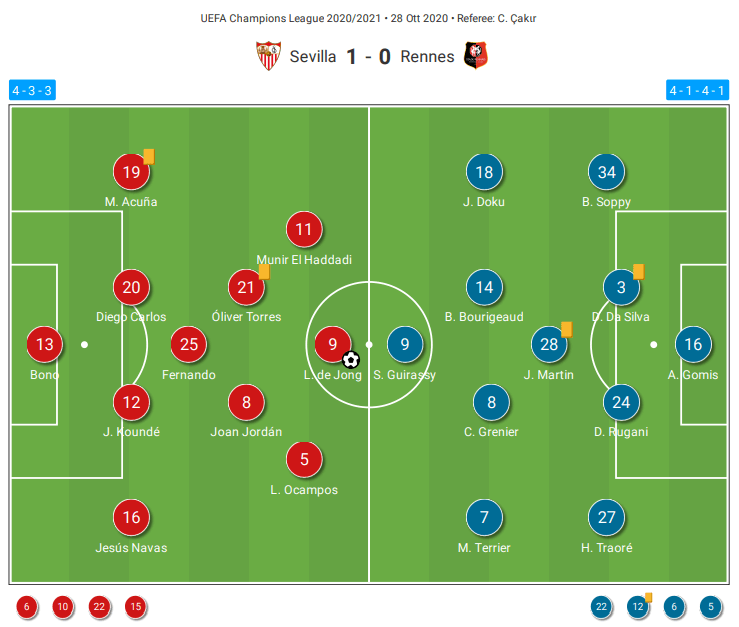
Julen Lopetegui used a 4-3-3 in this match, starting Bono in goal. At the back, the ageless Jesús Navas started on the right, French wunderkind Jules Koundé paired with Diego Carlos in the middle and former Sporting Portugal player, Marcos Acuña, patrolled the left. In midfield, Fernando played at the bottom of the triangle with Joan Jordán and Óliver Torres ahead of him. Rounding out the formation, Lucas Ocampos, Luuk de Jong and Munir El Haddadi started from right to left along the forward line.
Julien Stéphan’s 4-1-4-1 saw him start the Senegalese international, Gomis, in goal and was rewarded with a brilliant performance. Brandon Soppy, captain Damien Da Silva, Daniele Rugani and Hamari Traoré. Jonas Martin played the pivot with Benjamin Bourigeaud and Clément Grenier in front of him. Jérémy Doku and Martin Terrier ran the wings while Serhou Guirassy received the start up top. Steven N’Zonzi (suspension) and Eduardo Camavinga (injury) were missing from the midfield, then Stéphan was forced to account for another injury as Nayef Aguerd replaced Rugani in the 17th minute.
Sevilla’s high press
From the onset, Sevilla set the tone with a high-tempo, expansive attack and a relentless press. A 6.5 PPDA (passes per defensive action) and 25 opposition half recoveries, compared to the 12 of Rennes, put the Ligue 1 side on their heels. One of the tactics Sevilla used when out of possession was a man-marking high press. The only exceptions to the man-marking were plus one at the back with Koundé and Diego Carlos against one Rennes forward, as well as wide players ready to defend against two players, one more central and the long-range target in the wing.
Below have Sevilla set up in the man-marking high press. The striker, de Jong, arched his run to deny the passing lane to Da Silva. A risky pass to Bourigeaud is the only short or intermediate option, forcing Gomis to play long.
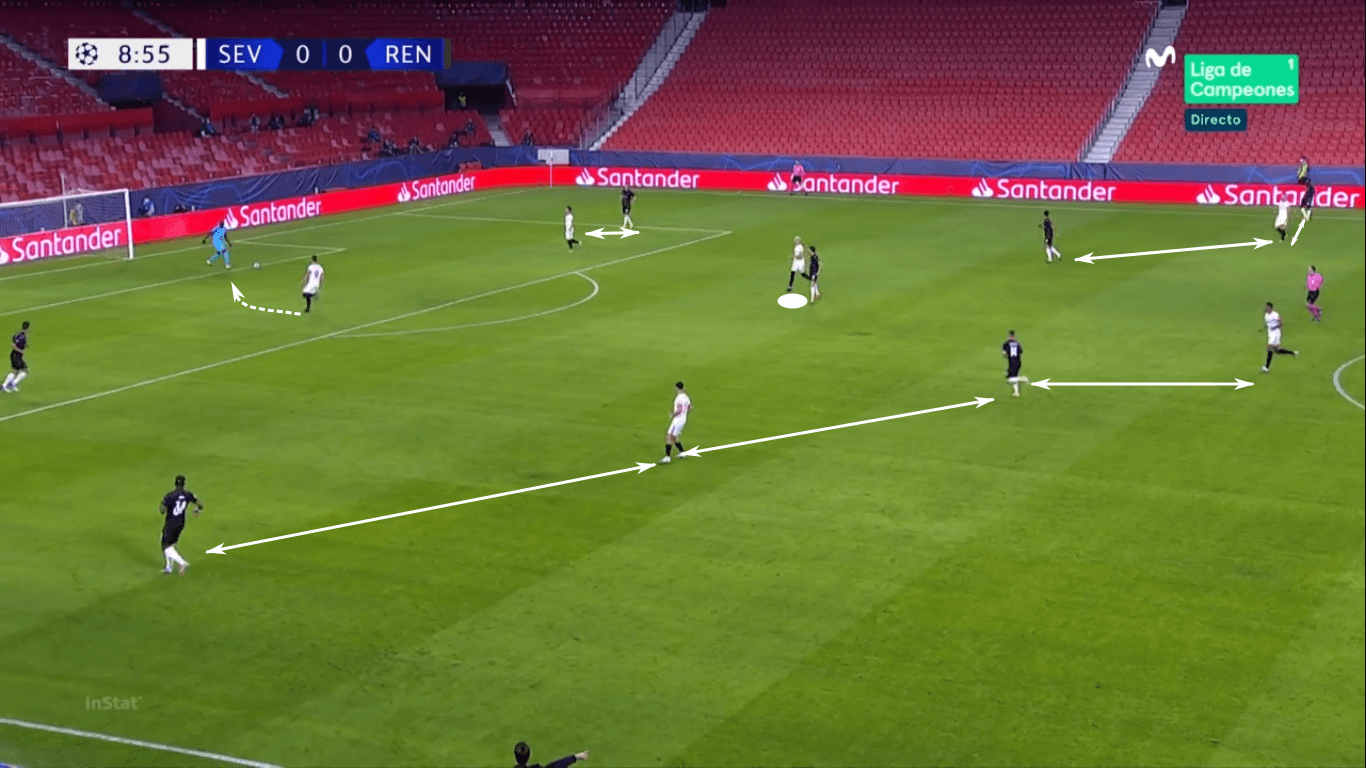
Munir, who was positioned between the winger and right-centre midfielder, was first to the ball, claiming the interception for his side.
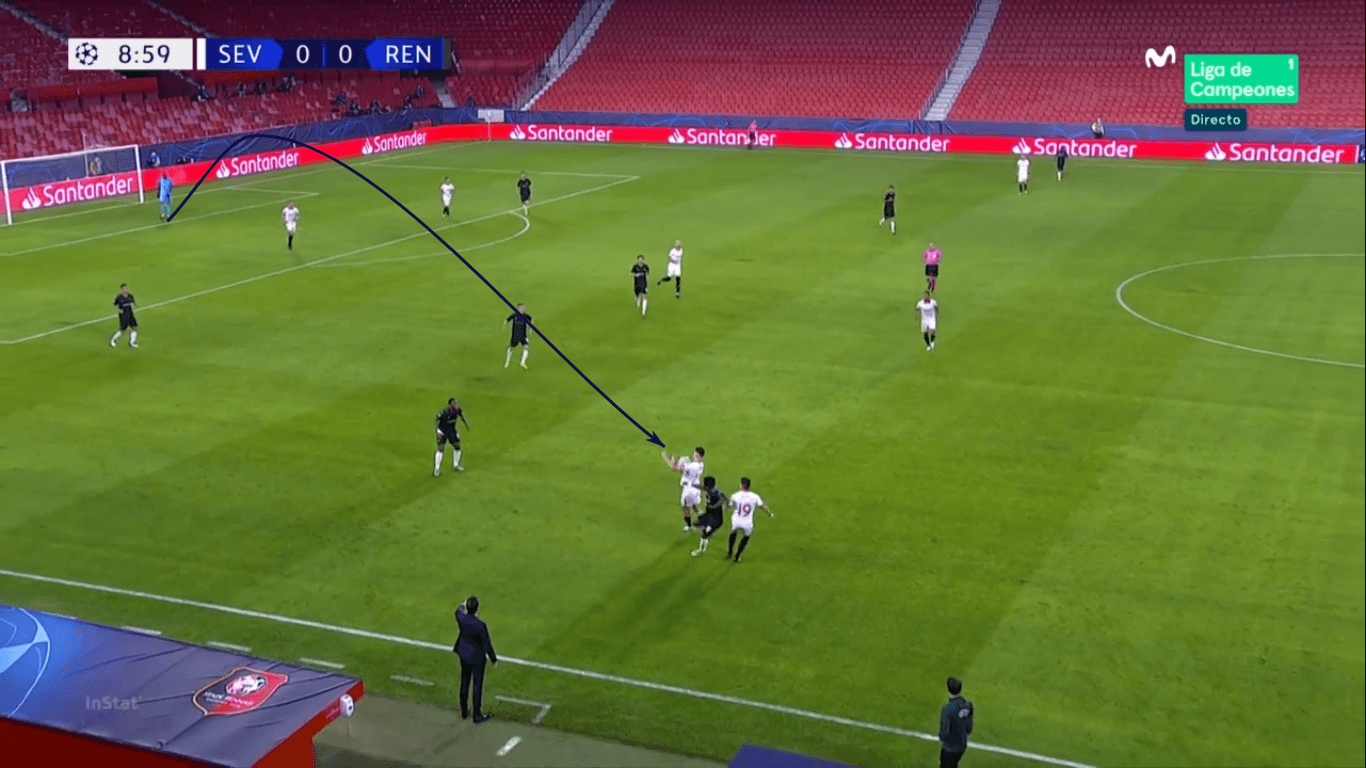
That high press was very effective, forcing Rennes into 37 long passes, a 14% share of their pass total. With Sevilla enjoying a numeric advantage at the back, Los Nervionenses managed to win 55% of the game’s aerial duels. Furthermore, the reigning Europa League champions managed to hold Rennes to a total of 21 attacks while forcing 30 clearances (compared to the three of Sevilla).
When Rennes managed to beat the man-marking high press, Sevilla was typically successful in funnelling the French side’s attack into the wings. Once the ball arrived wide, Sevilla transitioned into a very compact block with all 11 players on one vertical half of the pitch while snuffing out the short and intermediate passing lanes.
Restarts in the wings were also effective sources for structuring the press. Putting the ball out of ball allowed Sevilla to reset while eliminating easy options forward. Plus, as Rennes attempted to establish their attacking shape, moving the far-sided outlets higher and wider, Sevilla was quick to reclaim possession and direct in transition.
That analysis is shown in the image below. A miscue on the Rennes throw-in led to a Sevilla interception. Torres collected the ball and passed to Ocampos, who launched an effort just wide of the goal.
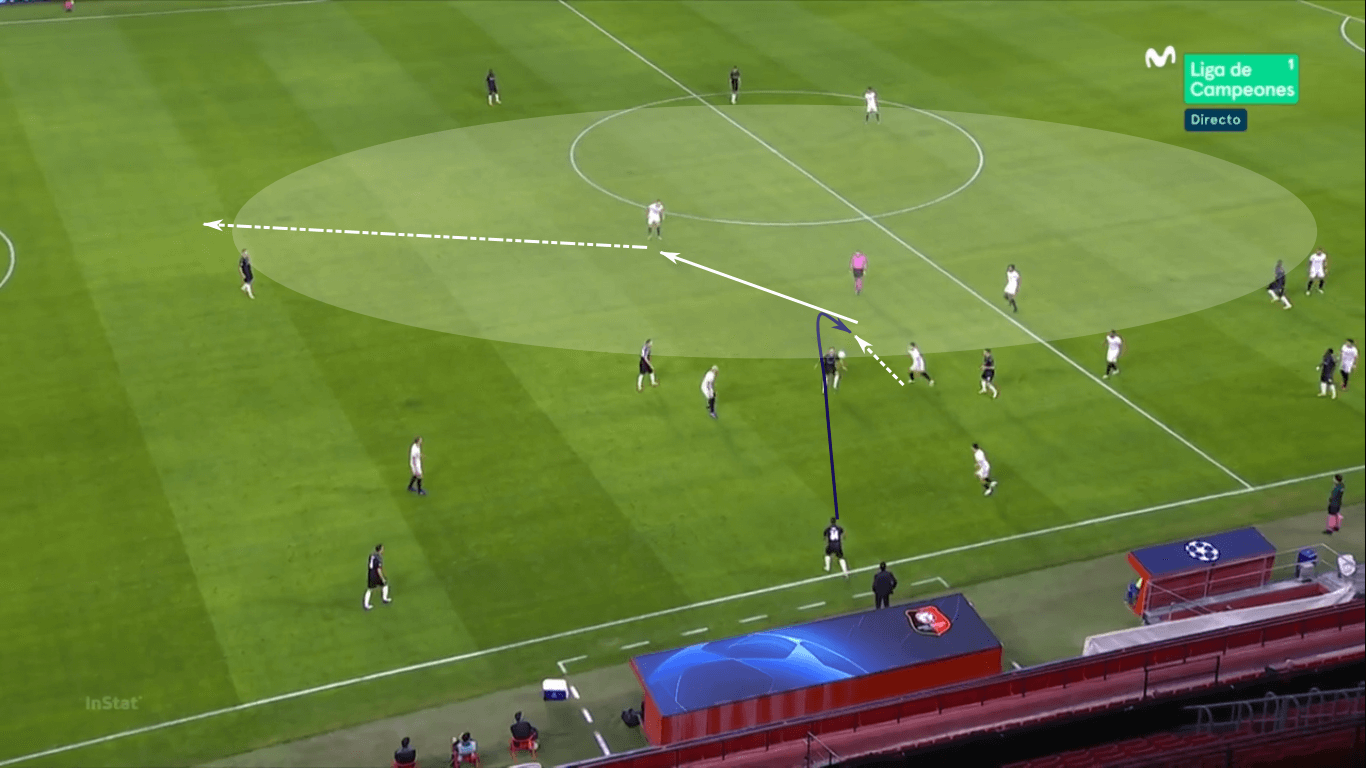
With the widest parts of Sevilla’s press in the central channel, the La Liga side routinely picked out central targets, breaking pressure and initiating a central move to goal. Of their 59 attacks, only 16 of them came through the middle, but they accounted for 0.82 of the side’s 2.17 xG (43%). Transitional attacks didn’t result in goals in this match, but the chances were certainly there thanks to an effective press in the opposition’s half.
Rennes’ issues breaking the press
This analysis has already mentioned Rennes’ lowly 21 total attacks. Even worse, only one of those attacks ended with a shot, which is a 5% success rate in attacks leading to shots. With two shots for the match, Rennes’ other attempt was from a set piece.
Les Rouge et Noir found it difficult to get anything going against this resolute Sevilla side. Given the home side’s massive advantage in possession (67-33), one would think Rennes would lean heavily on the counterattack to create scoring opportunities. For the game, Rennes managed just two counters, somehow managing two fewer than Sevilla.
Where did the Rennes attacking tactics and execution go wrong?
From a tactics standpoint, Rennes simply didn’t have an answer for Sevilla’s presence high up the pitch. With Sevilla bombing forward in numbers, overloading in the wings while also concentrating numbers centrally, the Rennes attack was frequently left with one, sometimes two, player high up the pitch.
With Sevilla pinning the French side deep in their end, the two wingers, often the targets when trying to break the counterpress, started from such deep positions they were largely ineffective. On those few occasions, Rennes managed to send Doku or Terrier, mostly the former, into space, the disconnect between the lines and lack of available options was painfully obvious, as is shown in the following sequence.
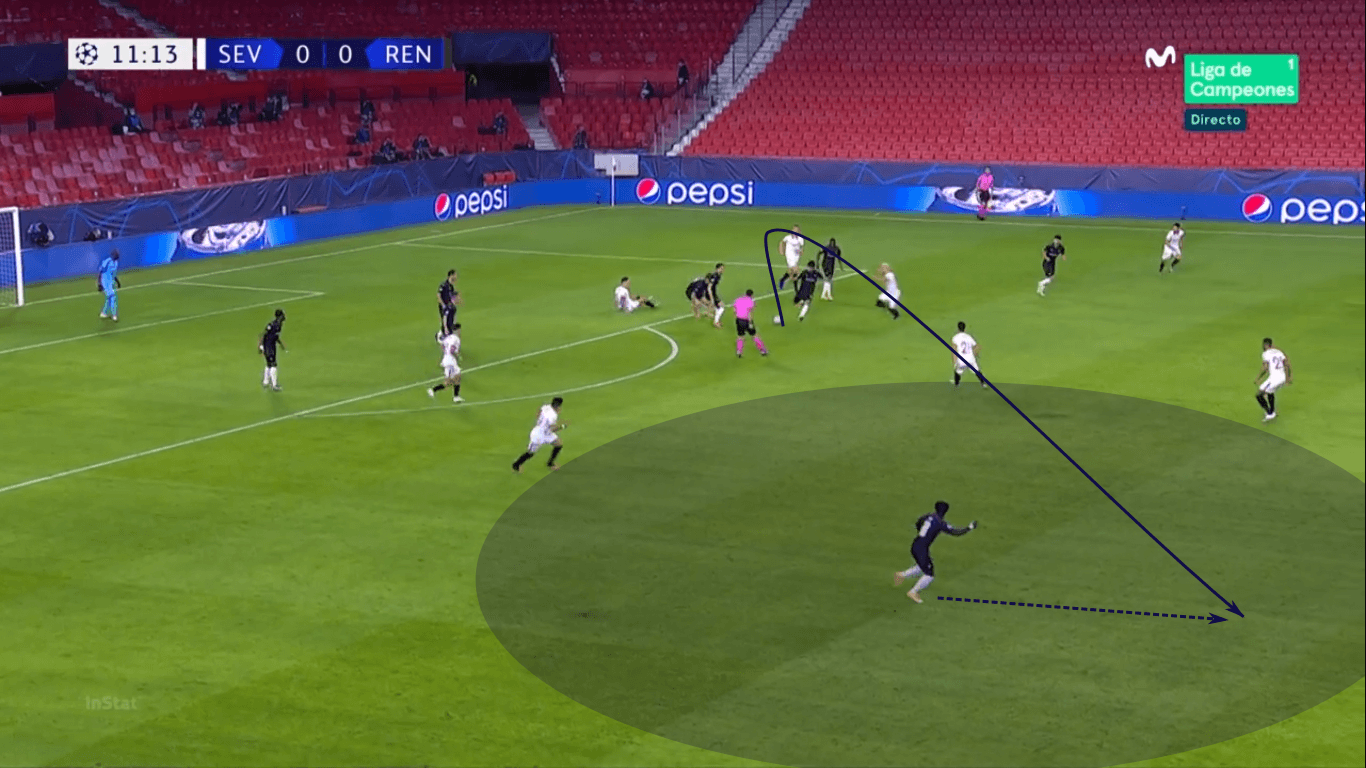
Grenier managed to win the ball and quickly pick out his wide target, Doku. The Belgian pushed the tempo of the attack, progressing through the dribble. However, once he reached the attacking third, he saw that Guirassy was the only player in support. They were quickly outnumbered by Sevilla, forcing Doku to hold up play to wait for his runners. A pass to Bourigeaud was immediately swung wide to Terrier.
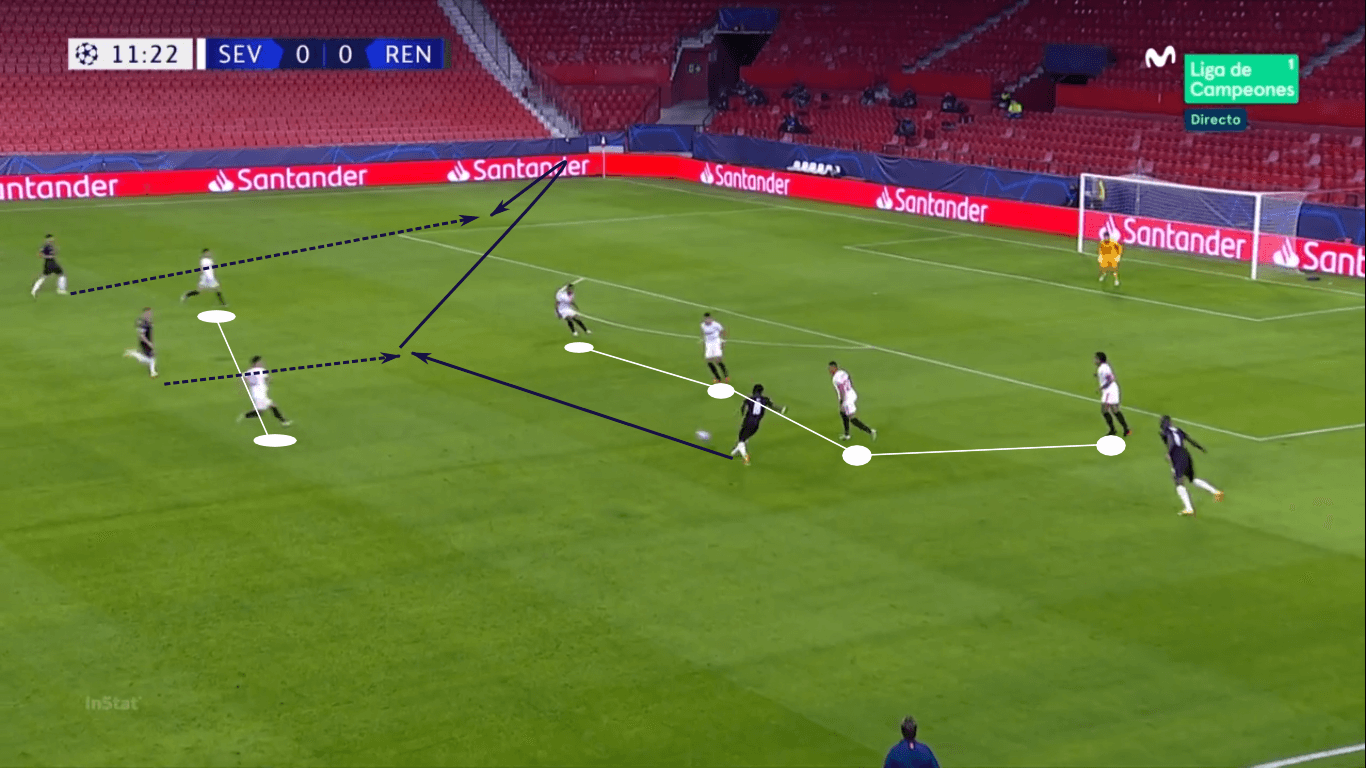
Tempo slowed further and the ball was set back to Grenier, the sixth player to arrive. By that point, Sevilla had ten players behind the ball, eliminating any direct or high percentage chances to goal. Rather than pulling Sevilla out of their low block and working for a better numerical and qualitative situation, Grenier dribbled into the box and saw his cross attempt block, trickling into the hands of Bono.
With so many players behind the ball and defending deep in their defensive third, Rennes forced a number of hopeful passes forward. That left a lot of work for Guirassy, who had a tough day at the office. To be fair, pitting him in a 1v2 against Koundé and Diego Carlos was an untenable strategy. Guirassy finished the match 29 for 80 in attacking actions, a team-worst 36% success rate.
Again, given the lack of support underneath and in the wings, it’s unfair to pin the blame on the Frenchman.
When Rennes managed to advance into the attacking third, counterattacks were killed by indecision while open possessions suffered from a lack of execution. In the example below, Doku was played behind the Sevilla line but was caught in the wing. As he turned to play an advancing runner, he found himself 2v8 with only Guirassy in support, but the passing lane to him was taken away. Holding the ball a few seconds longer, Doku played a negative pass to his late-arriving runners, who managed to find themselves in a pocket of space just outside the penalty arc.
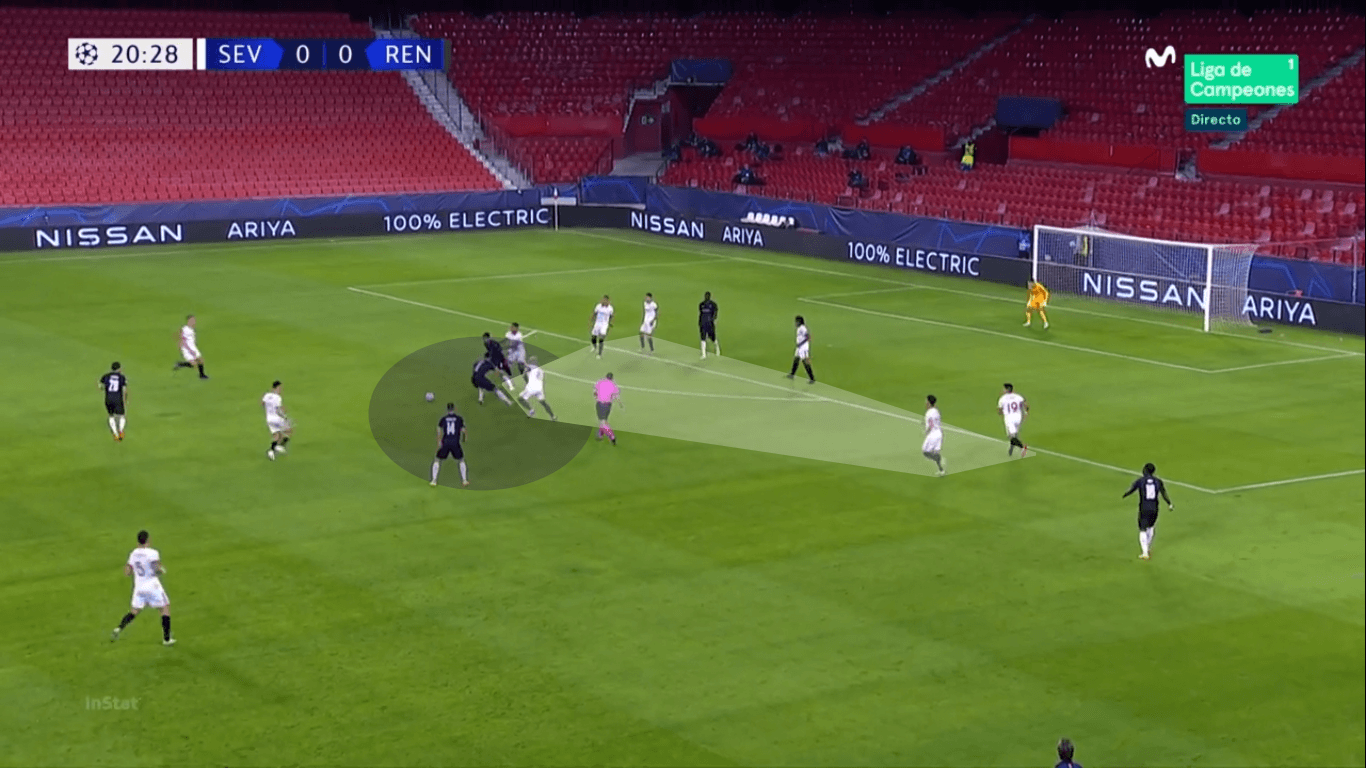
However, with Sevilla’s backline limiting the path to goal, indecision and miscommunication set in, allowing Sevilla to easily intercept a poor pass from Grenier.
That disconnect had haunted Rennes just eight minutes earlier. With Doku again making a run behind Acuña, Soppy failed to read the movement of his teammate, passing into his feet rather than space. Acuña easily intercepted the pass and restarted the attack.
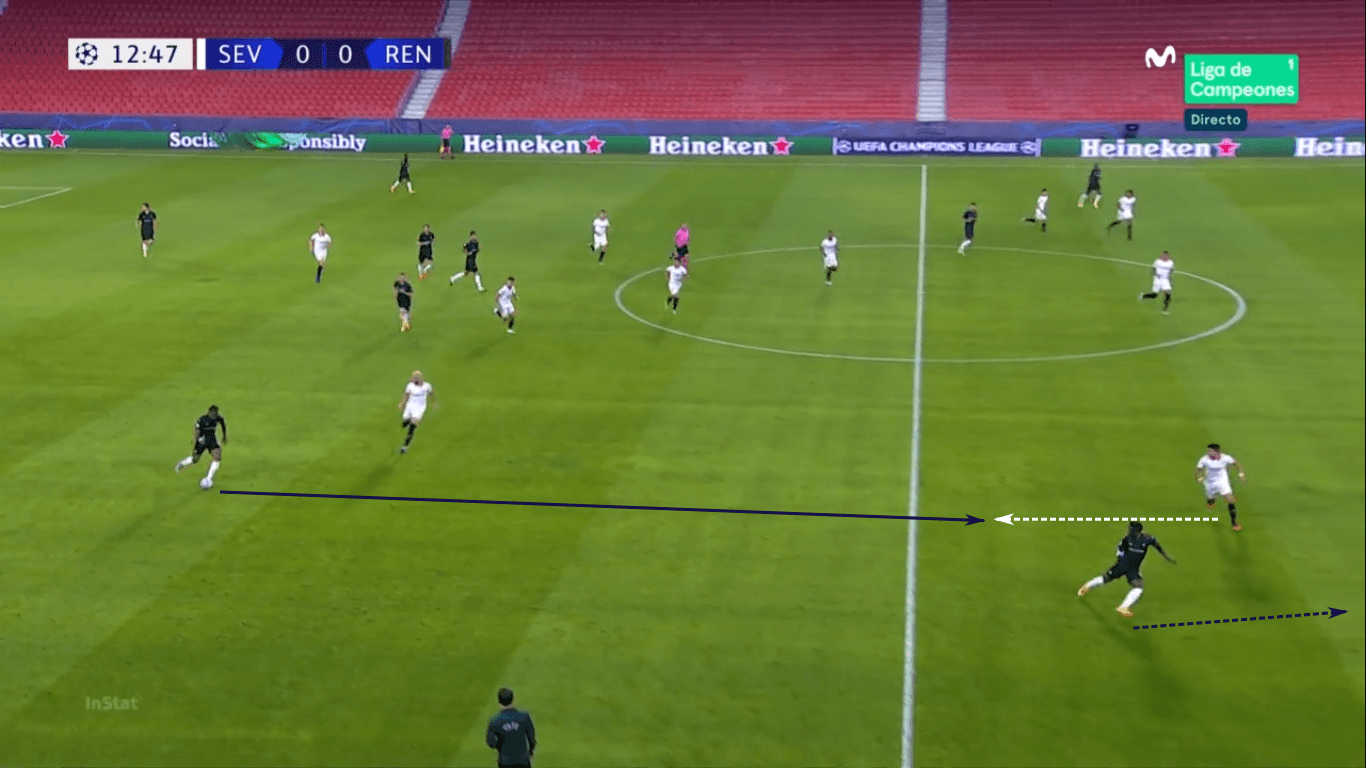
With just two shots in the game and a woeful 0.13 xG, indicative of the lack of goal scoring opportunities, this is a match Rennes will study with some difficulty. Poor in attack and unable to beat that Sevilla press, it’s a game with lots of questions marks for the visiting side.
Sevilla’s long diagonals
Coming into the match with an expectation of possession dominance, Sevilla’s task was breaking down this Ligue 1 side that conceded just 24 goals in 28 matches last season. That defensive mark tied Rennes with PSG, a mere three goals allowed behind league-leading Reims. To gain something from this match, Sevilla would need to keep the opposition unbalanced, both vertically and horizontally.
Lopetegui’s side did just that. With an average width of 49 metres and an average formation depth of 54 metres, their expansive, possession dominant attack stretched the Rennes press and routinely exploited the emerging gaps. Their ability to keep the ball for long stretches, yet still deliver high-quality scoring opportunities was incredibly impressive. 21 Sevilla attacks were considered long (20-45 seconds) and another seven were very long (45+ seconds). In contrast, six of Rennes’ possessions were long, one was very long.
Of Sevilla’s 59 total attacks, 18 finished with shots, which equates to 31%. You’ll recall 5% of Rennes’ open attacks ended with shots. Those stats give an idea of how unbalanced this match really was. Individual superiority was a major component in Sevilla’s success. For the match, they finished 18 for 31 (58%) on the dribble, much higher than Rennes’ 8 for 29 (28%).
Analysis of Sevilla’s attacks show they were very well distributed across left, centre and right vertical channels of the pitch. Additionally, attacks from each of the three regions were highly effective. For the match, Sevilla produced 15 key passes (passes that produce shots), which is quite outstanding. Let’s look at some of the variations in attack, all of which centre on the long diagonal pass.
First, we have the direct distribution from the centre-backs to the players occupying the wings. Acuña was especially active on the left, frequently running by Soppy. In the play below, the two are isolated on the wing. Sevilla’s right and central overloads have isolated Acuña on the wing, giving him the advantage of initiative.
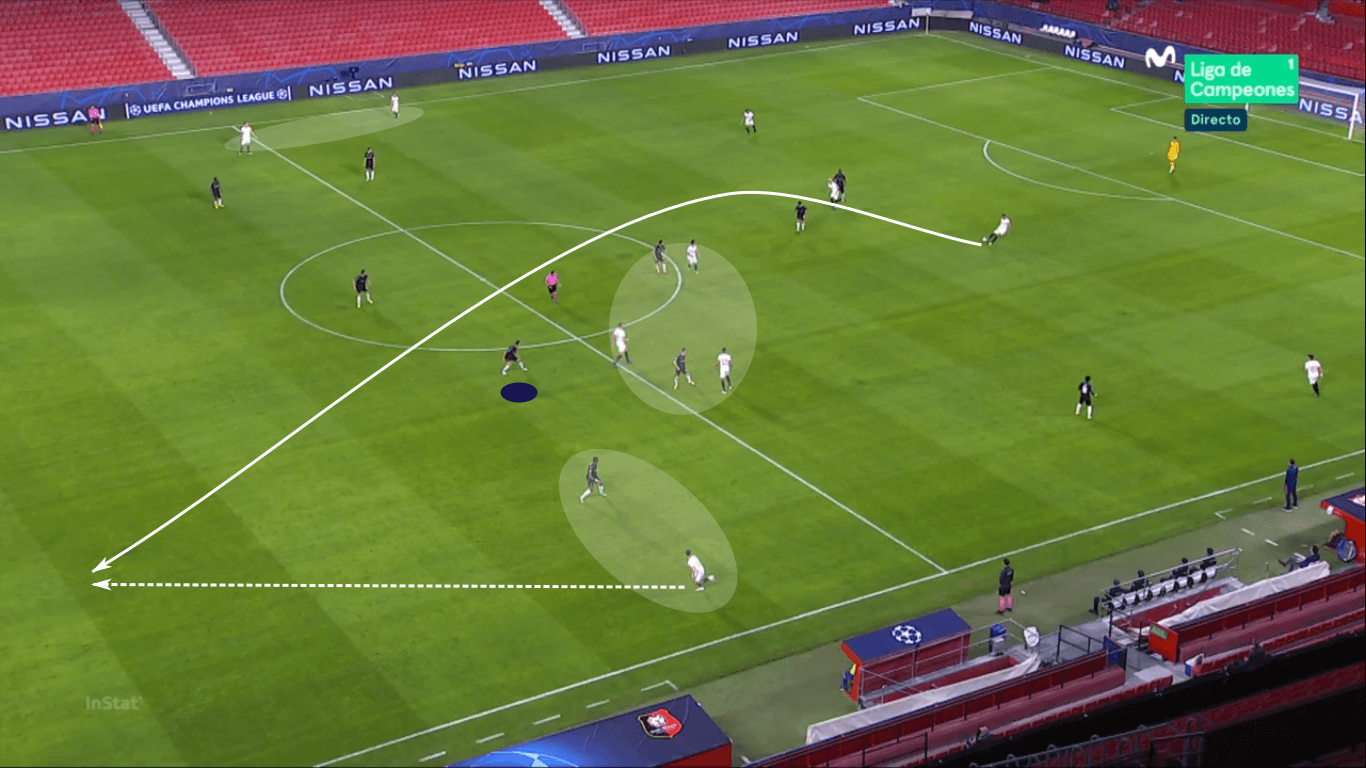
Those passes from the centre-backs weren’t exclusively to the near sided winger either. Koundé, in particular, had a number of brilliant cross-field deliveries to Munir and Acuña on the left. Below is one of Sevilla’s best goal-scoring opportunities. It started when the Frenchman hit a long diagonal to Acuña. As the Argentine chased it down, Ocampos made a hard run into the box.
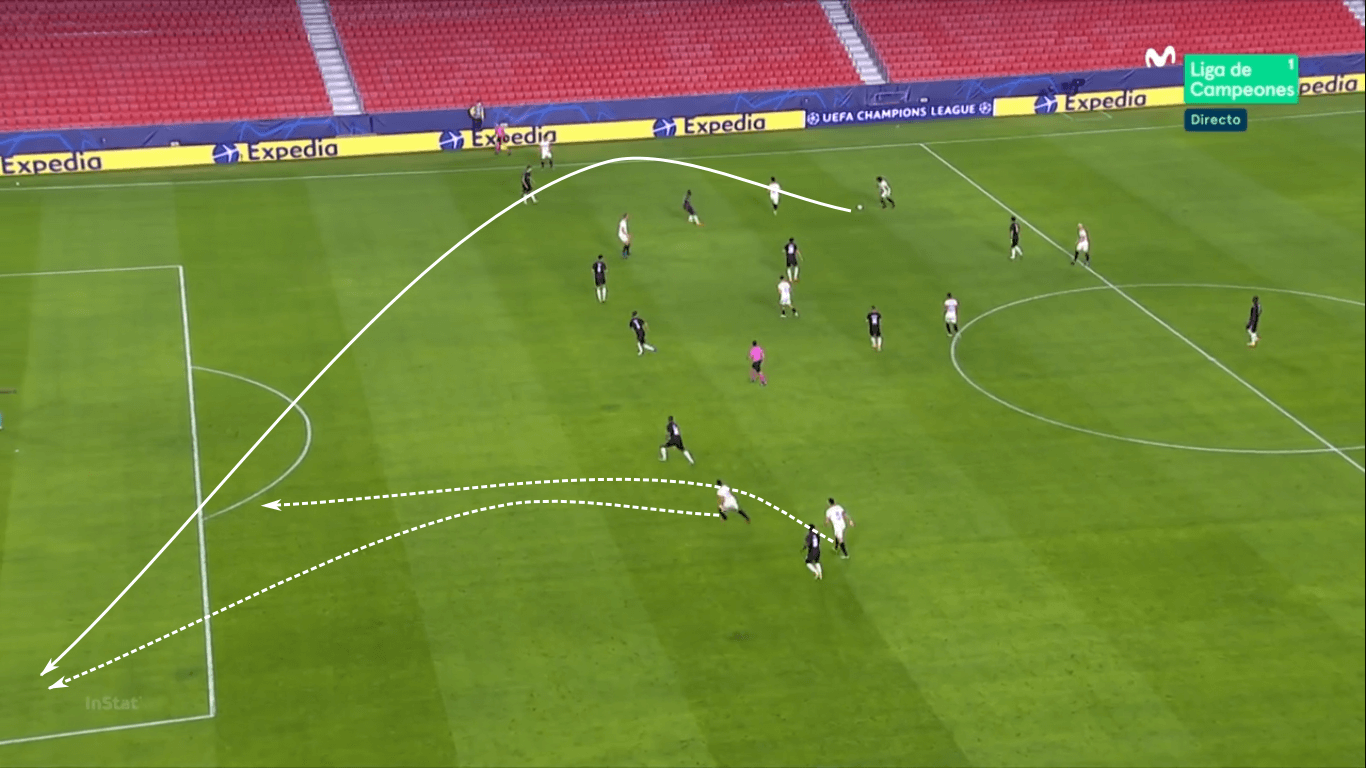
That hard run allowed Acuña to calmly volley a pass into his path. As you can see in the image below, Ocampos really should have put this chance to bed. Instead, another fantastic save from Gomis kept the score level.
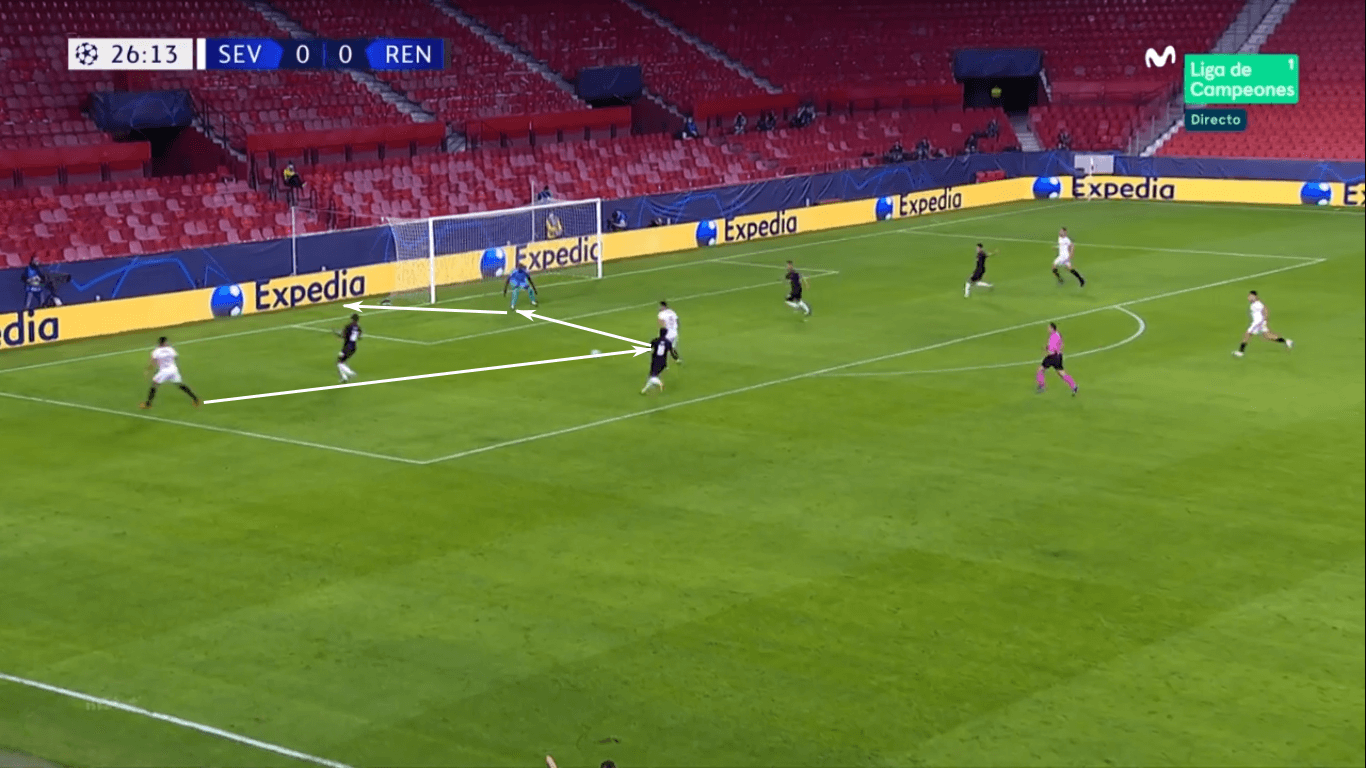
On Sevilla’s lone goal, Fernando found Acuña racing down the left and sent him a lofted pass. The Argentine brought it down and sent an early cross into the path of de Jong, who gave Sevilla a well-deserved breakthrough.
Sevilla’s second most common use of the long diagonal pass was to play into or out of overloads. The right side of the pitch was especially important in this tactical framework. With Navas, Ocampos and Jordán cleanly keeping possession, they frequently unbalanced the Rennes defence, creating massive pockets of space throughout the pitch.
In the sequence below, a tidy rondo created that imbalance, cueing Navas to switch the point of attack through Diego Carlos.
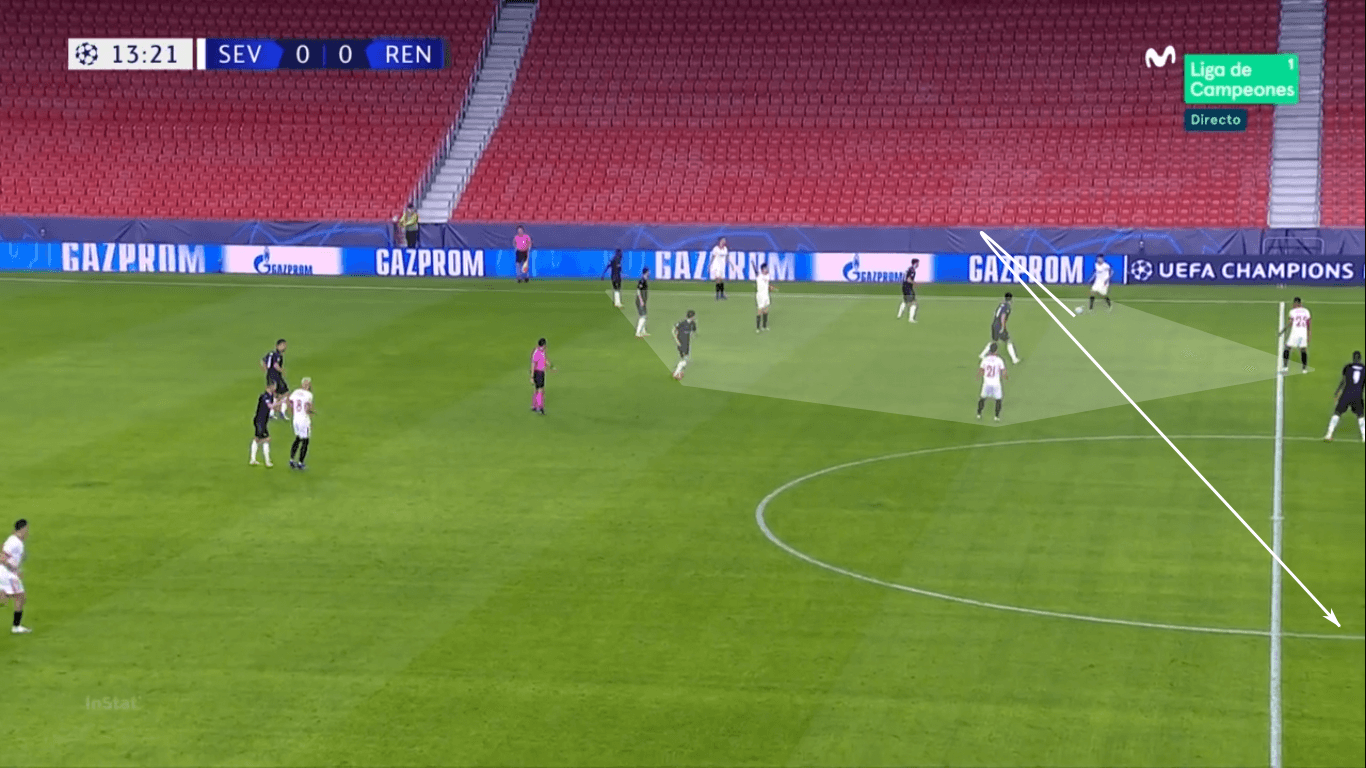
Rennes shifted right really well in this sequence, so Sevilla maintained their own right-sided overload. With only high-risk paths in front of him, Torres quickly sent the ball back to his right.
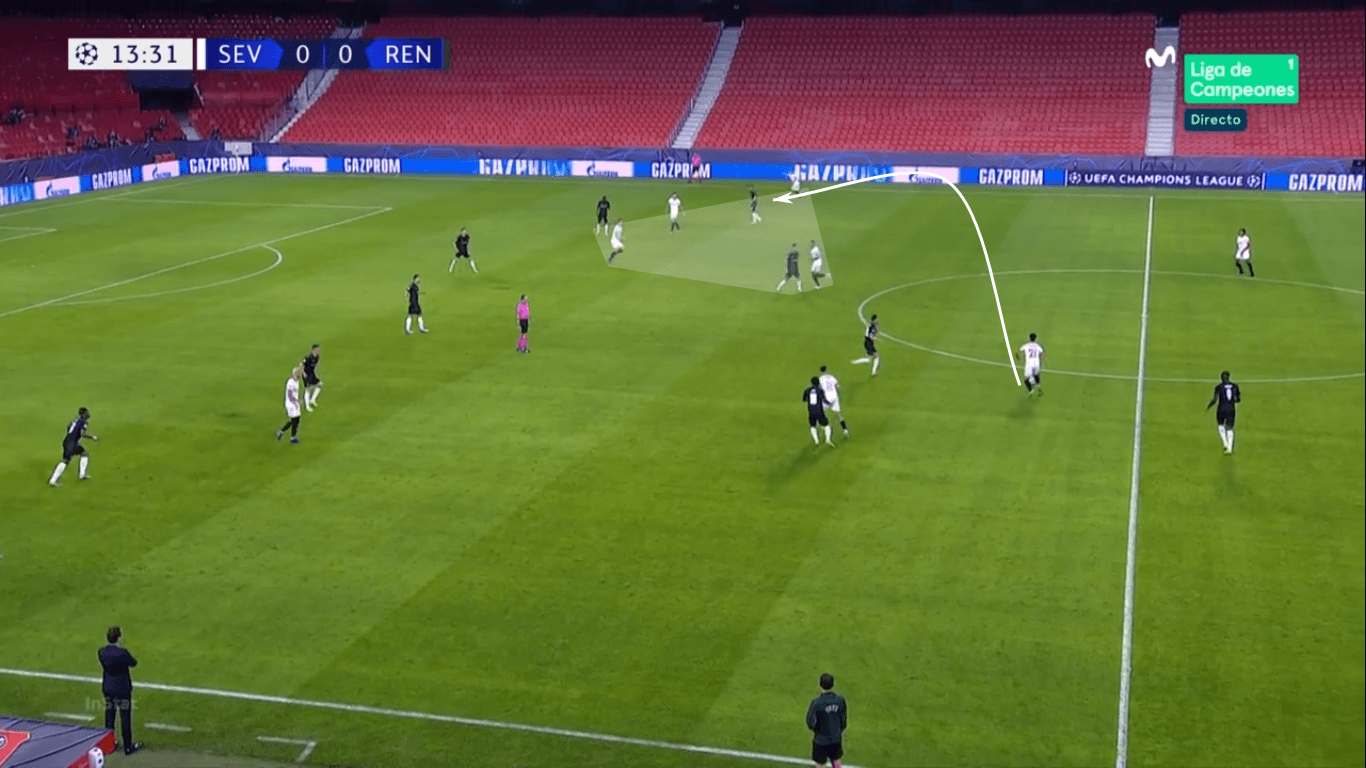
Our third pattern was the utilisation of de Jong as the target man. With the big Dutchman drifting between the half spaces, anticipating his opportunity to make a run on goal, Sevilla would occasionally look to use his aerial prowess in search of progression.
In this case, de Jong sees Torres looking for the long diagonal, so he offered a run into the box. Torres went for it, playing the ball directly in front of de Jong. Notice Ocampos, a constant threat in this one, running underneath de Jong.
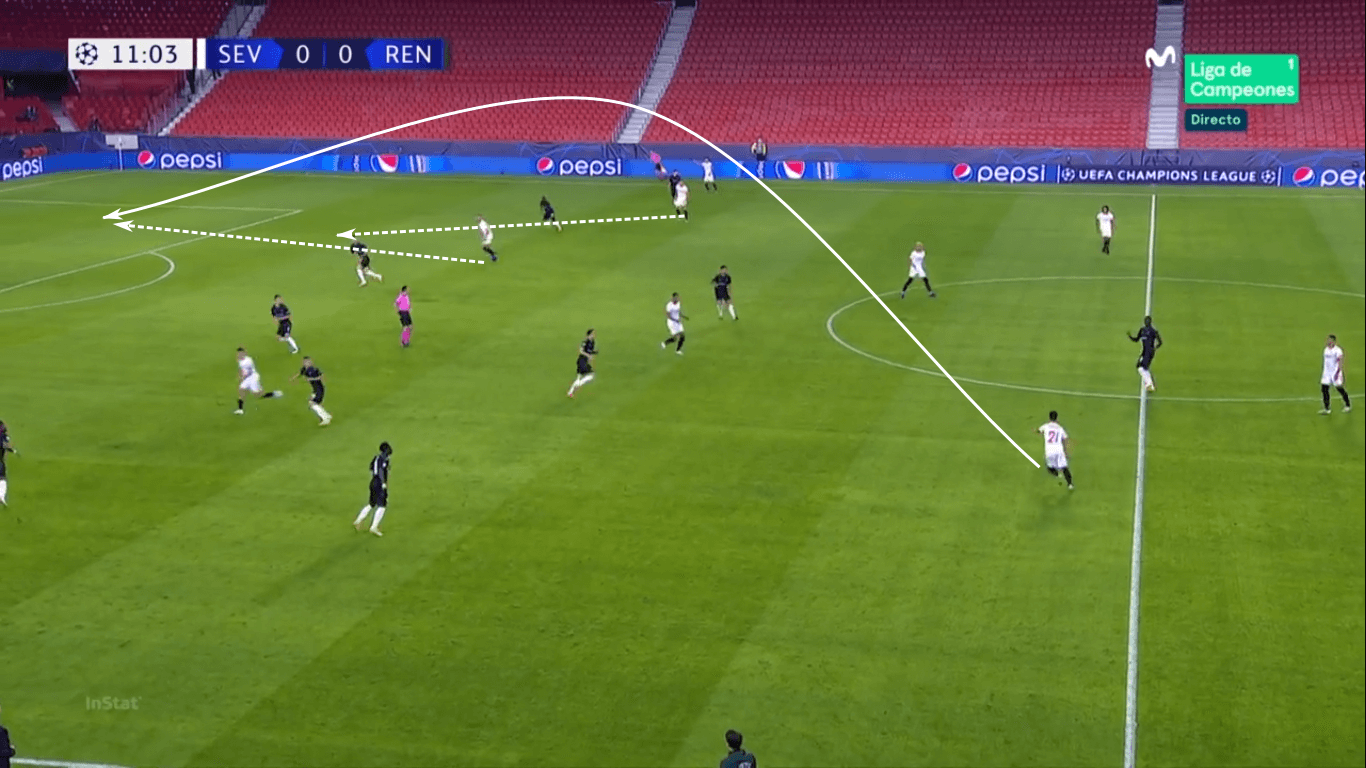
Though the long diagonal took de Jong away from goal, he managed to head it once to control the ball, then a second time to set for Ocampos. The big Argentine received in a large pocket of space, but wasn’t able to generate a shot as the Rennes defence made a nice recovery.
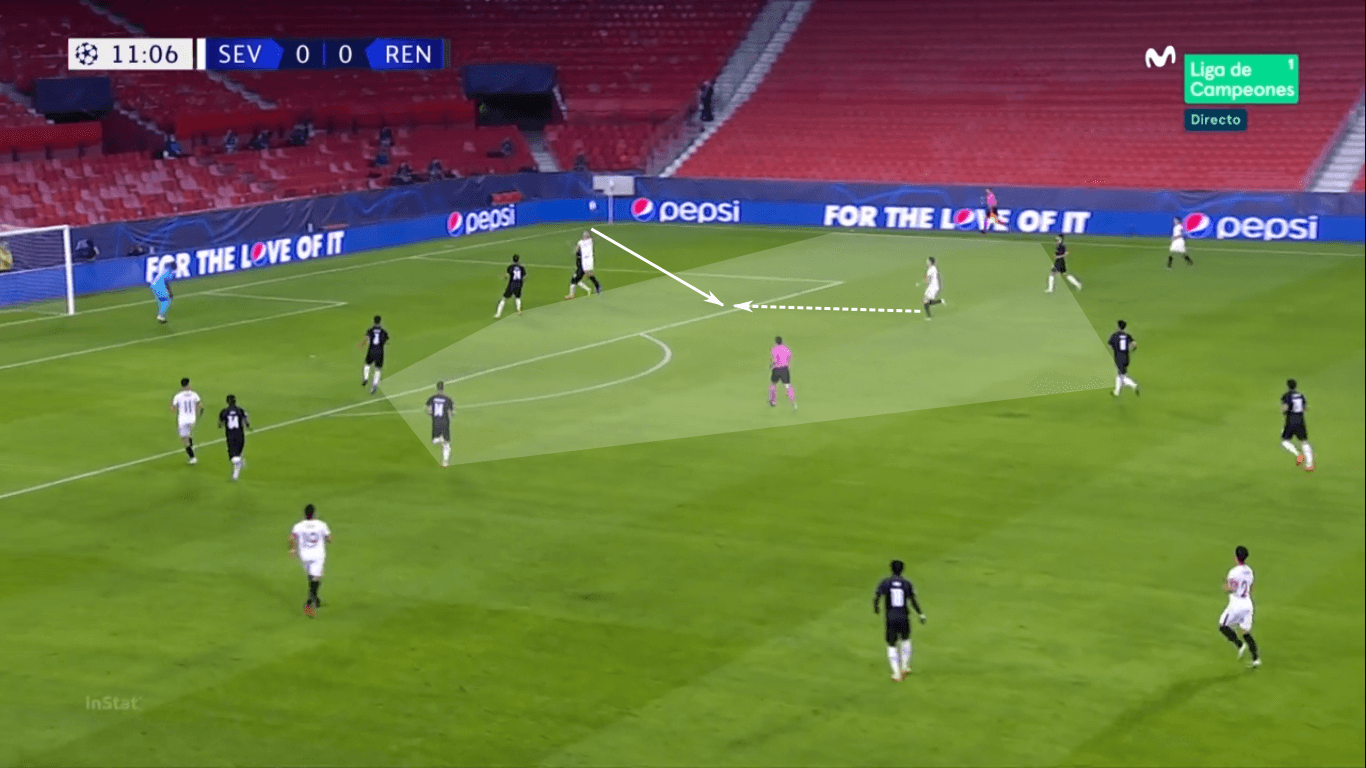
Our fourth, and final, pattern was right down the middle. In the image below, the key is Sevilla’s wide overloads, paired with de Jong occupying two defenders (one marking and the other covering). With the La Liga side enjoying a 4v3 advantage at the back, Koundé and Diego Carlos were able to swing the ball across the back while patiently awaiting the right opportunity.
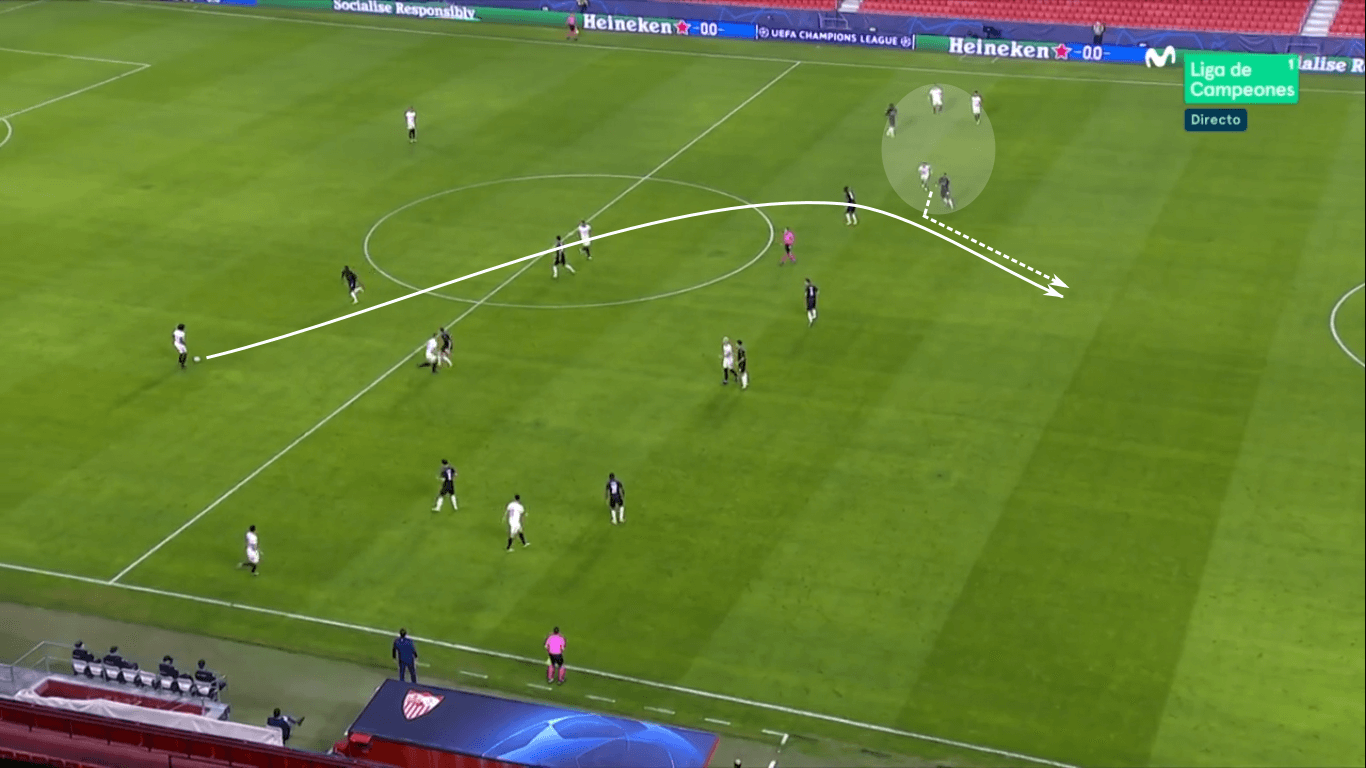
In this case, it was the young Frenchman who picked out the run of Munir. Though the former Barcelona man was offside on the play, Sevilla wasn’t afraid to test the Rennes backline through the central channel.
Conclusion
Stéphan and Les Rennais will walk away from this match highly disappointed with their performance. Flat in attack is one thing, but the leaky defence is rather worrisome. If not for a fantastic performance from Gomis and the mercy of the posts, this game could have gotten out of hand. They’ll look to right the ship in Ligue 1 against Brest, then rebound in the UEFA Champions League against Chelsea next week.
Lopetegui’s side has had a difficult start to the season. Following the draw against Barcelona, they’ve dropped two La Liga games and drawn 0-0 against Chelsea. While Los Palanganas will be disappointed they didn’t win this match by far more, they’ll be pleased with the number of chances they created, as well as the quality. A trip to Athletic Club is on Saturday’s itinerary, followed by a home match in the UEFA Champions League against Krasnodar.


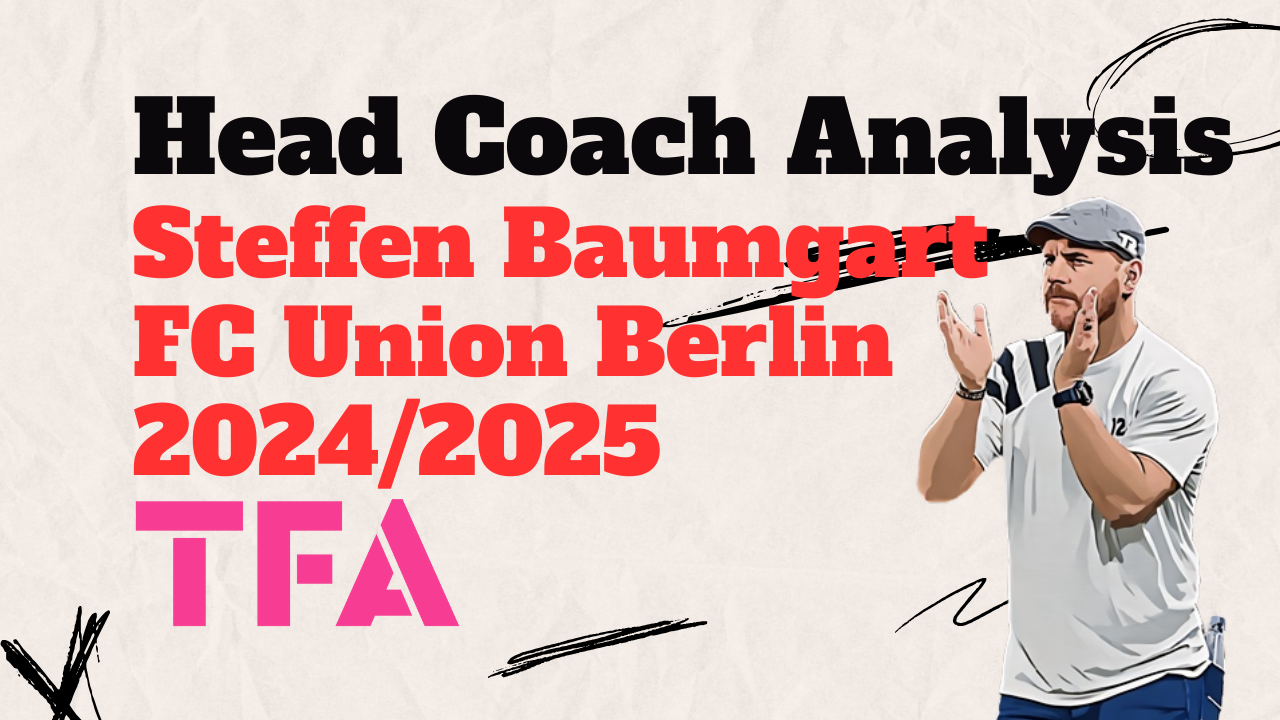
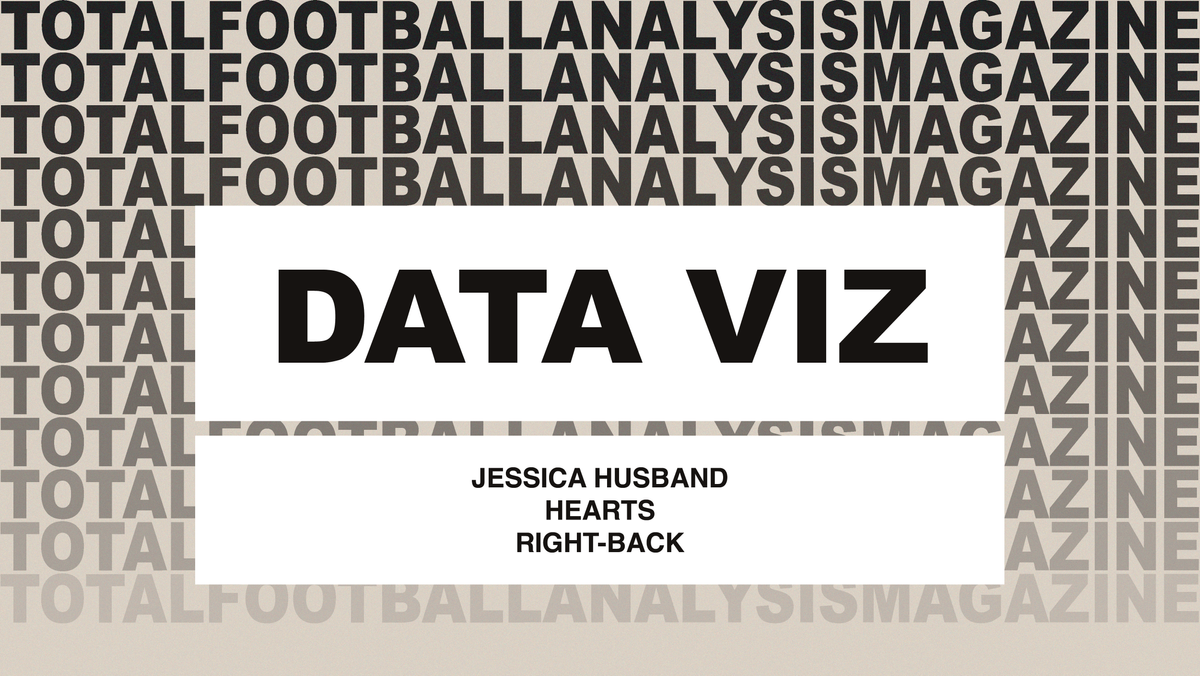
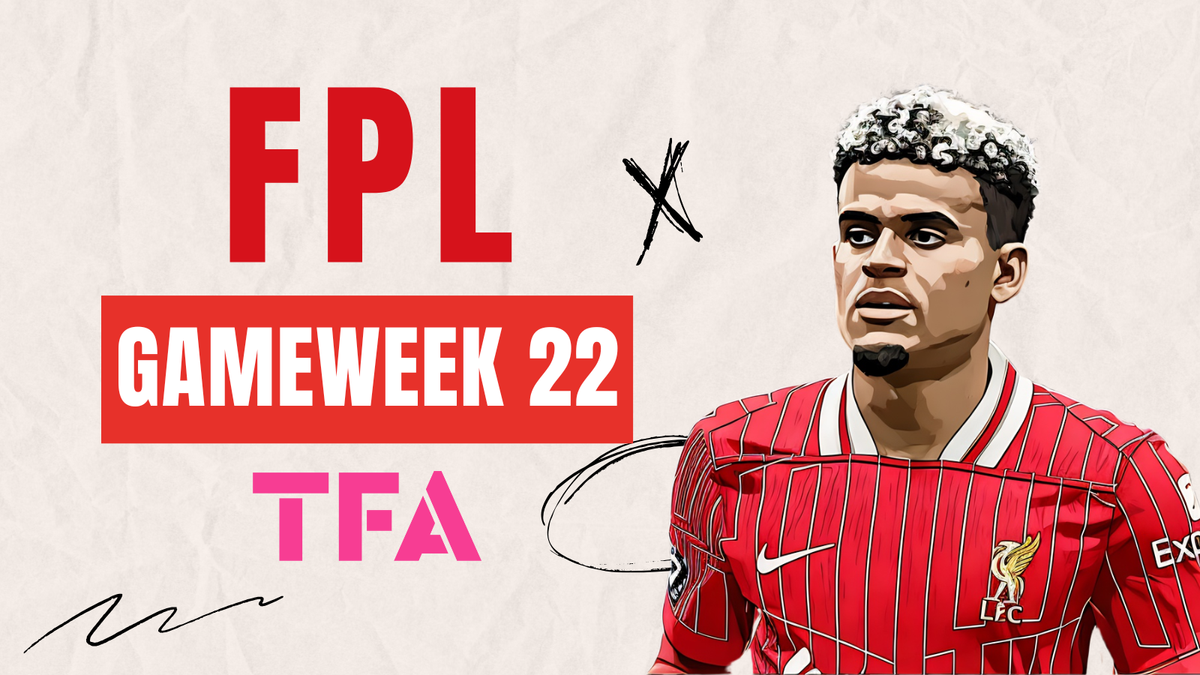
Comments